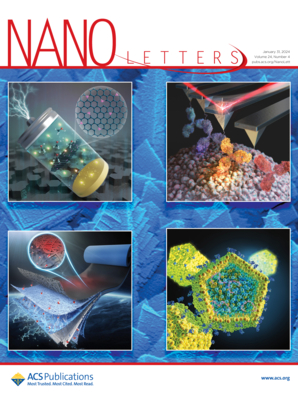Dual SOT Switching Modes in a Single Device Geometry for Neuromorphic Computing
IF 9.6
1区 材料科学
Q1 CHEMISTRY, MULTIDISCIPLINARY
引用次数: 0
Abstract
Neuromorphic computing aims to replicate the brain’s efficient processing through artificial neurons and synapses, requiring binary and multilevel switching. We present a PtMn/(Co/Pd)4/Ta device that uniquely enables dual spin–orbit torque (SOT) switching modes─binary and multilevel (analog)─within the same geometry and stack structure, eliminating the need for device modifications. Binary SOT switching is achieved via domain wall nucleation and propagation at moderate current levels (∼65 mA), while multilevel switching occurs via domain nucleation mode without significant propagation after a high-current treatment (∼85 mA). The transition between two modes originates from structural changes after the current treatment. These modes allow for neuronal and synaptic functionalities, with the device achieving 96% accuracy in digit/letter recognition on the MNIST data set using an artificial neural network (ANN). The device’s robust perpendicular magnetic anisotropy (PMA), dual-mode switching under a small in-plane field (HX), and simplified fabrication underscore its promise as an energy-efficient solution for neuromorphic computing.

神经形态计算中单器件几何中的双SOT切换模式
神经形态计算旨在通过人工神经元和突触复制大脑的高效处理,需要二进制和多级转换。我们提出了一种PtMn/(Co/Pd)4/Ta器件,该器件独特地在相同的几何形状和堆叠结构中实现双自旋-轨道扭矩(SOT)开关模式─二进制和多电平(模拟)─,从而消除了对器件修改的需要。二进制SOT开关在中等电流水平(~ 65 mA)下通过畴壁成核和传播实现,而多电平开关在大电流处理(~ 85 mA)后通过畴成核模式发生,没有显著的传播。两种模式之间的转换源于当前处理后的结构变化。这些模式允许神经元和突触功能,该设备使用人工神经网络(ANN)在MNIST数据集上实现96%的数字/字母识别准确率。该器件具有强大的垂直磁各向异性(PMA)、小面内场(HX)下的双模开关和简化的制造工艺,突显了其作为神经形态计算节能解决方案的前景。
本文章由计算机程序翻译,如有差异,请以英文原文为准。
求助全文
约1分钟内获得全文
求助全文
来源期刊

Nano Letters
工程技术-材料科学:综合
CiteScore
16.80
自引率
2.80%
发文量
1182
审稿时长
1.4 months
期刊介绍:
Nano Letters serves as a dynamic platform for promptly disseminating original results in fundamental, applied, and emerging research across all facets of nanoscience and nanotechnology. A pivotal criterion for inclusion within Nano Letters is the convergence of at least two different areas or disciplines, ensuring a rich interdisciplinary scope. The journal is dedicated to fostering exploration in diverse areas, including:
- Experimental and theoretical findings on physical, chemical, and biological phenomena at the nanoscale
- Synthesis, characterization, and processing of organic, inorganic, polymer, and hybrid nanomaterials through physical, chemical, and biological methodologies
- Modeling and simulation of synthetic, assembly, and interaction processes
- Realization of integrated nanostructures and nano-engineered devices exhibiting advanced performance
- Applications of nanoscale materials in living and environmental systems
Nano Letters is committed to advancing and showcasing groundbreaking research that intersects various domains, fostering innovation and collaboration in the ever-evolving field of nanoscience and nanotechnology.
 求助内容:
求助内容: 应助结果提醒方式:
应助结果提醒方式:


